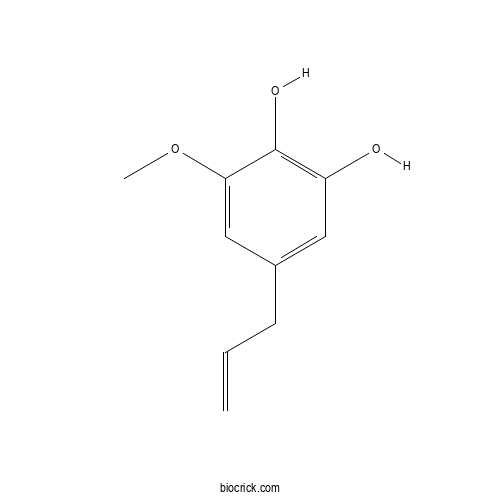5-Allyl-1-methoxy-2,3-dihydroxybenzeneCAS# 4055-72-5 |

Quality Control & MSDS
3D structure
Package In Stock
Number of papers citing our products

| Cas No. | 4055-72-5 | SDF | Download SDF |
| PubChem ID | 11389746 | Appearance | Powder |
| Formula | C10H12O3 | M.Wt | 180.2 |
| Type of Compound | Phenols | Storage | Desiccate at -20°C |
| Solubility | Soluble in Chloroform,Dichloromethane,Ethyl Acetate,DMSO,Acetone,etc. | ||
| Chemical Name | 3-methoxy-5-prop-2-enylbenzene-1,2-diol | ||
| SMILES | COC1=CC(=CC(=C1O)O)CC=C | ||
| Standard InChIKey | BHIIRUKUMCZDIB-UHFFFAOYSA-N | ||
| Standard InChI | InChI=1S/C10H12O3/c1-3-4-7-5-8(11)10(12)9(6-7)13-2/h3,5-6,11-12H,1,4H2,2H3 | ||
| General tips | For obtaining a higher solubility , please warm the tube at 37 ℃ and shake it in the ultrasonic bath for a while.Stock solution can be stored below -20℃ for several months. We recommend that you prepare and use the solution on the same day. However, if the test schedule requires, the stock solutions can be prepared in advance, and the stock solution must be sealed and stored below -20℃. In general, the stock solution can be kept for several months. Before use, we recommend that you leave the vial at room temperature for at least an hour before opening it. |
||
| About Packaging | 1. The packaging of the product may be reversed during transportation, cause the high purity compounds to adhere to the neck or cap of the vial.Take the vail out of its packaging and shake gently until the compounds fall to the bottom of the vial. 2. For liquid products, please centrifuge at 500xg to gather the liquid to the bottom of the vial. 3. Try to avoid loss or contamination during the experiment. |
||
| Shipping Condition | Packaging according to customer requirements(5mg, 10mg, 20mg and more). Ship via FedEx, DHL, UPS, EMS or other couriers with RT, or blue ice upon request. | ||

5-Allyl-1-methoxy-2,3-dihydroxybenzene Dilution Calculator

5-Allyl-1-methoxy-2,3-dihydroxybenzene Molarity Calculator
| 1 mg | 5 mg | 10 mg | 20 mg | 25 mg | |
| 1 mM | 5.5494 mL | 27.7469 mL | 55.4939 mL | 110.9878 mL | 138.7347 mL |
| 5 mM | 1.1099 mL | 5.5494 mL | 11.0988 mL | 22.1976 mL | 27.7469 mL |
| 10 mM | 0.5549 mL | 2.7747 mL | 5.5494 mL | 11.0988 mL | 13.8735 mL |
| 50 mM | 0.111 mL | 0.5549 mL | 1.1099 mL | 2.2198 mL | 2.7747 mL |
| 100 mM | 0.0555 mL | 0.2775 mL | 0.5549 mL | 1.1099 mL | 1.3873 mL |
| * Note: If you are in the process of experiment, it's necessary to make the dilution ratios of the samples. The dilution data above is only for reference. Normally, it's can get a better solubility within lower of Concentrations. | |||||

Calcutta University

University of Minnesota

University of Maryland School of Medicine

University of Illinois at Chicago

The Ohio State University

University of Zurich

Harvard University

Colorado State University

Auburn University

Yale University

Worcester Polytechnic Institute

Washington State University

Stanford University

University of Leipzig

Universidade da Beira Interior

The Institute of Cancer Research

Heidelberg University

University of Amsterdam

University of Auckland

TsingHua University

The University of Michigan

Miami University

DRURY University

Jilin University

Fudan University

Wuhan University

Sun Yat-sen University

Universite de Paris

Deemed University

Auckland University

The University of Tokyo

Korea University
- Auranamide
Catalog No.:BCX2140
CAS No.:740813-53-0
- Terrestriamide
Catalog No.:BCX2139
CAS No.:157536-49-7
- Quercetin-5-O-glucoside-3-O-rutinoside
Catalog No.:BCX2138
CAS No.:1478622-04-6
- Praeroside I
Catalog No.:BCX2137
CAS No.:121064-73-1
- Cryptostigmin II
Catalog No.:BCX2136
CAS No.:50906-57-5
- Davidigenin
Catalog No.:BCX2135
CAS No.:23130-26-9
- Pinocembrin 7-O-neohesperidoside
Catalog No.:BCX2134
CAS No.:13241-31-1
- Gerardianin A
Catalog No.:BCX2133
CAS No.:137171-31-4
- Euphopiloside A
Catalog No.:BCX2132
CAS No.:1610615-04-7
- Graciliflorin F
Catalog No.:BCX2131
CAS No.:1413941-67-9
- Eugenol 4-O-beta-D-(6'-O-galloyl) glucopyranoside
Catalog No.:BCX2130
CAS No.:152041-15-1
- Plumbagic acid
Catalog No.:BCX2129
CAS No.:75640-06-1
- Notoginsenoside E
Catalog No.:BCX2142
CAS No.:193976-50-0
- Hydrastinine
Catalog No.:BCX2143
CAS No.:5936-29-8
- 15-O-Methylgraciliflorin F
Catalog No.:BCX2144
CAS No.:1411994-51-8
- 4-Hydroxy-2-methoxybenzoic acid
Catalog No.:BCX2145
CAS No.:90111-34-5
- Mangostanin
Catalog No.:BCX2146
CAS No.:463342-39-4
Identification and characterization of reactive metabolites in myristicin-mediated mechanism-based inhibition of CYP1A2.[Pubmed:26091900]
Chem Biol Interact. 2015 Jul 25;237:133-40.
Myristicin belongs to the methylenedioxyphenyl or allyl-benzene family of compounds, which are found widely in plants of the Umbelliferae family, such as parsley and carrot. Myristicin is also the major active component in the essential oils of mace and nutmeg. However, this compound can cause adverse reactions, particularly when taken inappropriately or in overdoses. One important source of toxicity of natural products arises from their metabolic biotransformations into reactive metabolites. Myristicin contains a methylenedioxyphenyl substructure, and this specific structural feature may allow compounds to cause a mechanism-based inhibition of cytochrome P450 enzymes and produce reactive metabolites. Therefore, the aim of this work was to identify whether the role of myristicin in CYP enzyme inhibition is mechanism-based inhibition and to gain further information regarding the structure of the resulting reactive metabolites. CYP cocktail assays showed that myristicin most significantly inhibits CYP1A2 among five CYP enzymes (CYP1A2, CYP2D6, CYP2E1, CYP3A4 and CYP2C19) from human liver microsomes. The 3.21-fold IC50 shift value of CYP1A2 indicates that myristicin may be a mechanism-based inhibitor of CYP1A2. Next, reduced glutathione was shown to block the inhibition of CYP1A2, indicating that myristicin utilized a mechanism-based inhibition. Phase I metabolism assays identified two metabolites, 5-Allyl-1-methoxy-2,3-dihydroxybenzene (M1) and 1'-hydroxymyristicin or 2',3'-epoxy-myristicin (M2). Reduced glutathione capturing assays captured the glutathione-M1 adduct, and the reactive metabolites were identified using UPLC-MS(2) as a quinone and its tautomer. Thus, it was concluded that myristicin is a mechanism-based inhibitor of CYP1A2, and the reactive metabolites are quinone tautomers. Additionally, the cleavage process of the glutathione-M1 adduct was analyzed in further detail. This study provides additional information on the metabolic mechanism of myristicin inhibition and improves risk evaluation for this compound.
Roles of human liver cytochrome P450 3A4 and 1A2 enzymes in the oxidation of myristicin.[Pubmed:12523956]
Toxicol Lett. 2003 Feb 3;137(3):143-50.
The aim of this work was to identify the form(s) of human liver cytochrome P450 (CYP) involved in the hepatic transformation of myristicin to its major metabolite, 5-Allyl-1-methoxy-2,3-dihydroxybenzene. When microsomes prepared from different human liver samples were compared, the activity of 5-Allyl-1-methoxy-2,3-dihydroxybenzene formation was well correlated (r(2)=0.87) with nifedipine oxidation (a marker of CYP3A4). With a microsomal sample having high CYP3A4 activity, microsomal oxidation of myristicin to the major metabolite (5-Allyl-1-methoxy-2,3-dihydroxybenzene) was markedly inhibited by gestodene and ketoconazole, selective inhibitors of CYP3A enzymes, but not by any of several other P450 inhibitors. Antibodies raised against CYPs 3A4 and 1A2 could also inhibit the oxidation of myristicin, but antibodies recognizing other CYPs had no effect. The oxidation of myristicin to 5-Allyl-1-methoxy-2,3-dihydroxybenzene was catalyzed by purified bacterial recombinant CYPs 3A4 and 1A2. These results provide evidence that CYP3A4 (and possibly other CYP3A enzymes) and CYP1A2 play roles in the formation of the major metabolite, 5-Allyl-1-methoxy-2,3-dihydroxybenzene.
In vitro and in vivo metabolism of myristicin in the rat.[Pubmed:9521577]
J Chromatogr B Biomed Sci Appl. 1998 Feb 13;705(2):367-72.
Myristicin [5-allyl-1-methoxy-2,3-(methylenedioxy)benzene] is a flavoring plant constituent and has been known to produce significant psychopharmacological responses as well as insecticidal activity. From in vitro and in vivo metabolism of myristicin, the two metabolites 5-Allyl-1-methoxy-2,3-dihydroxybenzene and 1'-hydroxymyristicin were identified using GC-MS after derivatization of sample matrices with a mixture of BSTFA-TMCS. Those metabolites from in vitro study were also confirmed in urine after an oral administration of myrisitcin to rats, and enzymatic hydrolysis of urine suggested that these metabolites were excreted as conjugated forms as well.


